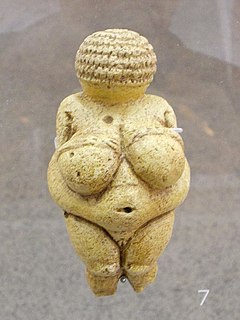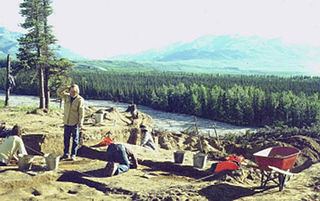Related Research Articles

Anthropology is the scientific study of humanity, concerned with human behavior, human biology, cultures, societies, and linguistics, in both the present and past, including past human species. Social anthropology studies patterns of behaviour, while cultural anthropology studies cultural meaning, including norms and values. A portmanteau sociocultural anthropology is commonly used today. Linguistic anthropology studies how language influences social life. Biological or physical anthropology studies the biological development of humans.
Ian Richard Hodder is a British archaeologist and pioneer of postprocessualist theory in archaeology that first took root among his students and in his own work between 1980–1990. At this time he had such students as Henrietta Moore, Ajay Pratap, Nandini Rao, Mike Parker Pearson, Paul Lane, John Muke, Sheena Crawford, Nick Merriman, Michael Shanks and Christopher Tilley. As of 2002, he is Dunlevie Family Professor of Anthropology at Stanford University in the United States.

Material culture is the aspect of social reality grounded in the objects and architecture that surround people. It includes the usage, consumption, creation, and trade of objects as well as the behaviors, norms, and rituals that the objects create or take part in. Some scholars also include other intangible phenomena that include sound, smell and events, while some even consider language and media as part of it. The term is most commonly used in archaeological and anthropological studies, to define material or artifacts as they are understood in relation to specific cultural and historic contexts, communities, and belief systems. Material culture can be described as any object that humans use to survive, define social relationships, represent facets of identity, or benefit peoples' state of mind, social, or economic standing. Material culture is contrasting to symbolic culture, which includes nonmaterial symbols, beliefs, and social constructs.

Gender archaeology is a method of studying past societies through their material culture by closely examining the social construction of gender identities and relations.
Lake Corangamite, a hypersaline endorheic lake, is located near Colac in the Lakes and Craters region of the Victorian Volcanic Plains of south-west Victoria, Australia. The lake's salinity levels have increased dramatically as the lake level has dropped in recent decades. It is Australia's largest permanent saline lake, covering approximately 230 square kilometres (89 sq mi) with a circumference of 150 kilometres (93 mi). It forms part of the Ramsar-listed Western District Lakes wetland site. The indigenous name of the lake is recorded as Kronimite.

Alfred William Howitt, , also known by author abbreviation A.W. Howitt, was an Australian anthropologist, explorer and naturalist. He was known for leading the Victorian Relief Expedition, which set out to establish the fate of the ill-fated Burke and Wills expedition.
Elizabeth M. Brumfiel was an American archaeologist who taught at Northwestern University and Albion College. She had been a president of the American Anthropological Association.
Public anthropology, according to Robert Borofsky, a professor at Hawaii Pacific University, "demonstrates the ability of anthropology and anthropologists to effectively address problems beyond the discipline—illuminating larger social issues of our times as well as encouraging broad, public conversations about them with the explicit goal of fostering social change". The work of Partners In Health is one illustration of using anthropological methods to solve big or complicated problems.

George Robert Fischer was an American underwater archaeologist, considered the founding father of the field in the National Park Service. A native Californian, he did undergraduate and graduate work at Stanford University, and began his career with the National Park Service in 1959, which included assignments in six parks, the Washington, D.C. Office, and the Southeast Archaeological Center from which he retired in 1988. He began teaching courses in underwater archaeology at Florida State University in 1974 and co-instructed inter-disciplinary courses in scientific diving techniques. After retirement from the NPS his FSU activities were expanded and his assistance helped shape the university's program in underwater archaeology.

The Dry Creek Archeological Site is an archaeological site not far outside Denali National Park and Preserve. It is a multi-component site, whose stratified remains have yielded evidence of human occupation as far back as 11,000 years ago. The site is located on the northern flanks of the Alaska Range, near Healy, Alaska, in the Nenana River watershed. There are four major components to the site, layered in an outwash terrace overlooking Dry Creek, with layers of loess separating them.

Coles Creek culture is a Late Woodland archaeological culture in the Lower Mississippi valley in the Southeastern Woodlands. It followed the Troyville culture. The period marks a significant change in the cultural history of the area. Population increased dramatically and there is strong evidence of a growing cultural and political complexity, especially by the end of the Coles Creek sequence. Although many of the classic traits of chiefdom societies are not yet manifested, by 1000 CE the formation of simple elite polities had begun. Coles Creek sites are found in Arkansas, Louisiana, and Mississippi. It is considered ancestral to the Plaquemine culture.
The World Oral Literature Project was "an urgent global initiative to document and disseminate endangered oral literatures before they disappear without record". Directed by Dr Mark Turin and co-located at the Museum of Archaeology and Anthropology, at the University of Cambridge and Yale University, the project was established in January 2009.
William "Bill" Culican was an Australian archaeologist and lecturer in biblical archaeology and pre-classical antiquity at the University of Melbourne.
The Archaeological and Anthropological Society of Victoria or AASV is an incorporated association formed in 1976 in Melbourne, Australia through the amalgamation of two earlier societies, the Anthropological Society of Victoria formed in 1934, and the Archaeological Society of Victoria formed in 1964. The former was created from the efforts of gifted lecturer Frederic Wood Jones who attracted an enthusiastic non-academic audience to his public lectures in the 1930s. The latter was created in response to the Centre for Adult Education (CAE) archaeology lectures of University of Melbourne academic William (Bill) Culican. The AASV publishes the occasional journal The Artefact.
The Anthropological Society of Victoria was formed in 1934, in response to the efforts of gifted lecturer Frederic Wood Jones who attracted an enthusiastic non-academic audience to his public lectures in the 1930s.
The Keilor archaeological site was among the first places to demonstrate the antiquity of Aboriginal occupation of Australia when a cranium, unearthed in 1940, was found to be nearly 15,000 years old. Subsequent investigations of Pleistocene alluvial terraces revealed hearths about 31,000 years BP, making Keilor one of the earliest sites of human habitation in Australia. Remains of megafauna suggest a possible association with Aboriginal hunting.
The Bend Road archaeological site is an open site in Melbourne, Australia. It was discovered during survey and archaeological testing for the proposed Scoresby Freeway, which became the EastLink Freeway. The site is located in two separate areas on either side of Bend Road, Dandenong South where the freeway now intersects the former road, and originally covered about 12 hectares.
Sandor (Alexander) Gallus was a Melbourne archaeologist, most famous for his investigations of Pleistocene Aboriginal occupation at Koonalda Cave in South Australia and the Dry Creek archaeological site in Keilor, Australia, which helped demonstrate the great antiquity of Aboriginal occupation of Australia.
The Pumpkin Creek Site (Lv-49) is an archaeological site dating from the Archaic period in northern Love County, Oklahoma, which is along Oklahoma's border with Texas. The site was occupied from 7,000-9,5000 BP. Evidence indicates the site was occupied while humans made tools from high quality stone found here and then departed the site, returning when additional stone tools were needed. It is estimated that only 5% of the original site remains due to heavy erosion. It is 2 acres (0.81 ha) and lies on a hillside. Artifacts have been donated to the Stovall Museum, now the Sam Noble Oklahoma Museum of Natural History. During its use, there was more rainfall and vegetation in the present day. Humans ceased using the site circa 7,000 BP when the region became very dry and arid.
The Artefact is a peer-reviewed academic journal published annually by the Archaeological and Anthropological Society of Victoria.
References
- ↑ Presland, Gary (1998) ‘A.S. Gallus and the Archaeological Society of Victoria.’ The Artefact 21:9-13
- ↑ Margaret Bullen, Australian Anthropological Society, Annual Conference 2007 - Transforming Economies, Changing States,
- ↑ "History of the AASV". Archived from the original on 12 December 2010. Retrieved 3 December 2010.
- ↑ Activities of the Archaeological Society of Victoria Concerning the Confluence Site of the Dry Creek and the Maribyrnong River in 1974/75., http://dspace.flinders.edu.au/dspace/handle/2328/274